Knowledge and Beliefs on Mathematical Modelling Inferred in the Argumentation of a Prospective Teacher When Reflecting on the Incorporation of This Process in His Lessons
Abstract
:1. Introduction
- What argumentation does a prospective teacher make to justify the incorporation (or not) of mathematical modelling in his lessons?
- What knowledge, values, beliefs, and guidelines for action, among other aspects, are inferred in this argumentation?
2. Theoretical References
2.1. Mathematical Modelling
- Open, that is, not limited to specific answers or procedures.
- Complex, that is, given the information in the wording of the task, students must search for the relevant data for its solving.
- Realistic, that is, incorporating elements taken from the real world.
- Authentic, that is, consistent with an event that has occurred or could occur in reality (in terms of [51]).
- A problem that should not be solved by applying known algorithms (in terms of [52]) and that required strategies for its solving.
- Solvable through a modelling cycle, in which all the phases are passed through.
2.2. Didactic-Mathematical Knowledge and Competences Model (DMKC Model)
- Analysis of mathematical activity: This sub-competence is made up of (a) analysis of global meanings competence and (b) onto-semiotic analysis of mathematical practices competence [54].
- Analysis and management of the interaction and its effect on student learning.
- Analysis of norms and meta-norms.
- Assessment of the didactic suitability of teaching and learning processes.
2.2.1. Assessment of the Didactic Suitability of Teaching and Learning Processes Sub-Competence: Didactic Suitability Criteria
- Epistemic criterion: To assess whether the mathematics that is taught is ‘good mathematics’.
- Cognitive criterion: To assess, before starting the teaching and learning process, whether what is intended to be taught is at a reasonable distance from what the students know.
- Interactional criterion: To assess whether the interaction solves students’ doubts and difficulties.
- Mediational criterion: To assess the adequacy of resources and time used in the teaching and learning process.
- Affective (or emotional) criterion: To assess the students’ involvement (interest, motivation) in the teaching and learning process.
- Ecological criterion: To assess the adaptation of the teaching and learning process to the educational project of the school, the curricular guidelines, the conditions of the social and professional environment, etc.
2.2.2. Knowledge, Beliefs, and Conceptions
- Epistemic facet: Refers to the specialized knowledge of the mathematical dimension (use of various representations, arguments, problem-solving strategies, and partial meanings of a mathematical object), and incorporates notions such as ‘knowing mathematics with depth and breadth’ [6] and ‘specialized content knowledge’ [1].
- Cognitive facet: Refers to the knowledge about the cognitive aspects of students (difficulties, errors, conflicts, learning, etc.).
- Interactional facet: Refers to the knowledge about the interactions that arise in the classroom (teacher–students, student–student, student–resources, etc.).
- Mediational facet: Refers to the knowledge about the resources and media that can enhance student learning, and about the times designated for teaching.
- Affective facet: Refers to the knowledge about the affective, emotional, and attitudinal aspects of the students.
- Ecological facet: Refers to the knowledge about the different aspects (curricular, contextual, social, political, economic, etc.) that influence the management of student learning.
2.3. Argumentation
- Confrontation stage: Establishes the difference of opinion. In a non-mixed difference of opinion, this simply means that one party’s point of view is not immediately accepted by the other, but instead is met with doubt or criticism. In a mixed difference of opinion, the other party advances its opposing point of view.
- Opening stage: Refers to the starting points of the discussion and assigns the roles of protagonist and antagonist (in a mixed difference of opinion there are two protagonists and two antagonists). Moreover, the rules of the debate and the starting points are agreed upon.
- Argumentation stage: The protagonist defends his/her point of view against the antagonist’s persistent criticism, advancing arguments to meet the antagonist’s objections or to remove the antagonist’s doubts.
- Concluding stage: The parties evaluate the extent to which the resolution of the difference of opinion reached and in favor of whom. If the protagonist withdraws the point of view, the difference of opinion is resolved in favor of the antagonist; if the antagonist abandons his/her doubts, it is resolved in favor of the protagonist.
- Convergent structure: Two or more premises independently support the conclusion.
- Dependent structure: The premises are united to support the conclusion, i.e., both premises (or all of them) need each other to infer the conclusion.
- Divergent structure: The same premise is supporting more than one conclusion (it can be said that there are two or more unitary arguments).
- Chained structure: One of the propositions is the conclusion of a premise and, in turn, it is the premise of another conclusion.
3. Methodological Aspects
3.1. Research Context
3.2. Study Subject
3.3. Data Collection and Analysis
3.3.1. Group Reflection Sessions
- In the first session, the study subject described the context in which he was carrying out his educational internship and presented his didactic unit for the teaching of functions.
- In the second session, the content and considerations for the preparation of the MFP were discussed.
- We undertook a general review of the video recordings of the group reflection sessions, which allowed us to have a first appreciation of the development of this critical discussion and, at the same time, allowed us to make a timeless list of the ideas and positions of the participants.
- We transcribed the dialogues from the video recordings of the group reflection sessions, labelling each participant and their respective interventions.
- We identified the stages that appeared in the dialogue, according to the pragma–dialectics model. To do this, we justified each segment of dialogue with the definition of each stage of the model.
3.3.2. Study Subject’s MFP
- Firstly, we identified the criteria and components of the DSC with which the study subject related his reflections on modelling when he assessed the suitability of his didactic unit in the ‘Implementation analysis’ chapter. Various works have studied teacher reflection during the mathematics teachers’ education from different points of view (see [68] from didactic analysis; [69] from self-regulation practices; [70] from creativity; [30,31] from mathematical modelling; among others), whose common denominator has been that, by using the DSC, the prospective teachers’ knowledge can also be inferred. In this sense, we followed a content analysis methodology like that used by [31], focused on the ‘Implementation analysis’ chapter of the MFP, which consisted of (1) carrying out a search for keywords related to modelling (model, context, problem, real); (2) identifying the criterion and component of the DSC in which we found the keywords and the comment that contained them.
- Secondly, to identify the different structures of the arguments in the assessment of the didactic suitability that the study subject made in his MFP, we used the diagramming technique [34], which is more appropriate for an argumentative text, such as is the case of the MFP. The steps for diagramming are: (1) all propositions in the text are enclosed in curly brackets; (2) propositions are listed in order of appearance; (3) the argument is structured, spatially locating the place of the conclusion; (4) a way in which the premises are related is proposed. Finally, in the diagrams of the arguments we distinguished the propositions that referred to modelling from those that did not.
- Thirdly, we analyzed the modelling task proposed in the MFP, using the characterization for a problem of this type, also considering the phases of the modelling cycle that occurred (or could occur) for its solving.
4. Presentation and Analysis of Results
4.1. Analysis of the First Group Reflection Session
4.1.1. Confrontation Stage
“T1: How to introduce the topic of modelling with a topic of functions? Of course, when you reflect on this, there are many aspects to take into account, it does not only depend on your willingness to model, but it also depends on the conditions of the [educational] centre, on the type of students you will have, on the didactic unit… and that this problem is specific to each [educational] centre. We are going to take the opportunity to discuss the problem”.
4.1.2. Opening Stage
“T1: What is modelling? How can functions be introduced? And how can they be introduced in the specific case of your [educational] centre? Which has characteristics that are unique compared to other [educational institutions]. The reflection on the problem of modelling would be, to what extent can it be applied or not? And if it cannot be incorporated, why could it not be incorporated? Now, what we will do is that AD will explain to us a little about the characteristics of the [educational] centre in which he implements his didactic unit, […] and, later, he will explain his proposal of how he intends to introduce modelling”.
4.1.3. Argumentation Stage
“AD: The whole mathematics department works […] like a gear, that is, they all do exactly the same thing, the same exams, they coordinate even the dates of the exams, and that makes it a bit difficult to introduce something new. […]. The only problem that I have seen is that, based on what they have told me, during normal hours [sic], they do not have access to the computer room. So, certain modelling problems, for example, with GeoGebra or a spreadsheet where they can work with these tools, […] they will have to do it on their own and, at best, project with the computer on one of these [interactive] boards that they do have. That is right, but it cannot be an interactive thing with the students”.

“AD: [In the mathematics department] They have a peculiarity and that is that, in parallel to the solving of problems in class and the usual dynamics, they pose some problems that they call ‘Món Matemàtic’, which is still a slightly broader plan, which accompanies all the topics. That is, each subject has its ‘Món Matemàtic’ and is like a problem a little more in context and is a little more extensive. This problem, in this case, my idea was to focus it towards modelling [continues in the next Argument]”.

“AD: … and, therefore, with a modelling context with a specific topic, take advantage of a context that is a little richer and propose, because this was my idea, different problems or different questions that, step by step, address the entire topic of the functions section, so let them start with a single context: first, problems of graphical representation; next, we will begin with domain and range; to end up posing line equations and then solving something more complex using these tools. And that is more or less the idea I had”.

“AD: Yes, the idea is that, since it is the first time that they [the students] do functions, they can give the model that algebraic structure. Let them make the model themselves or let them look for information to make a model, unless the case is very simple, I am not very sure that they can do it. But, by giving them the model, by giving them the context and so that they can understand its parts, then apply it, I think it can be easier for them. And, also, that is why I have put in the last section that, precisely, it is that idea: once I give them the context, it is not that I give them the data that they fill in the model and they get an equation that they can represent, but it is the other way around, I give them the points and they, through those points, find the equation from which they can deduce the starting data, that is, as in the opposite direction. That would be the last thing, so in a way, they would not build the model, that is true, because the model and the context are fixed, but, at that level of complexity, I think they could not do it on their own [continues in the next Argument]”.
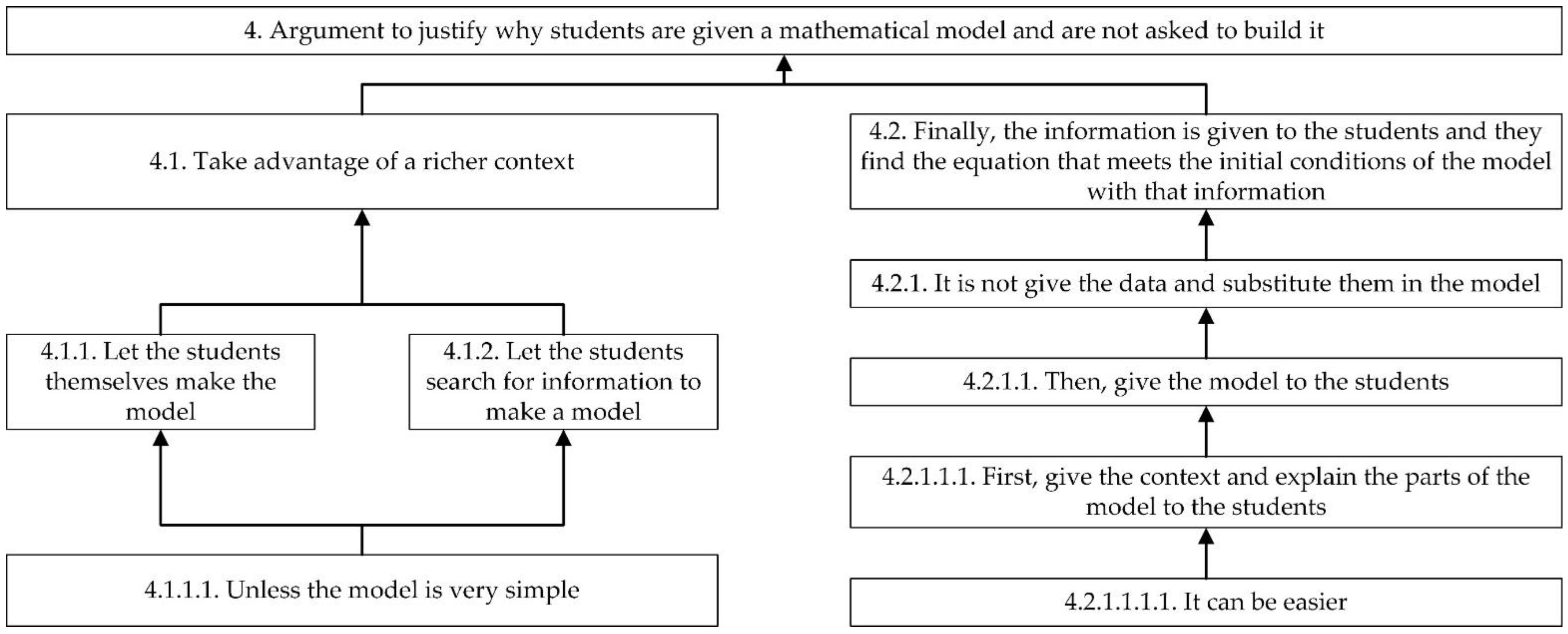
“AD: In that sense, perhaps this problem is not very creative for them, because they do not generate their own model, but adhere to an existing model, but, perhaps, since it is the first time they do it, surely, perhaps it is easier, because generating the model already means that they have a somewhat more advanced knowledge of mathematics, but also physics, I do not know, it could also be tried. […]. But, also, if you leave it [the problem] so open to them, I get the impression, from what I have seen, that maybe one or two of them will come up with a better or worse solution. I am not saying that it is good, but the rest, perhaps, surely, will not amount to anything. So, as a first stone in this world of modelling, perhaps it is better to give them a fixed context, that they handle themselves algebraically, understand a little and, perhaps in the fourth [grade of secondary education] or baccalaureate [education], then they already generate their own models. […]. What is a little more complicated for me is to leave them with such an open model but let them do it on their own. If I have them [the students] in class, and I dedicate the whole lesson to working on this based on questions that help them to build something, I do see that as more feasible, but give them a brushstroke of ten minutes and let that they on their own can develop an open work, perhaps it is more complicated, I do not know”.
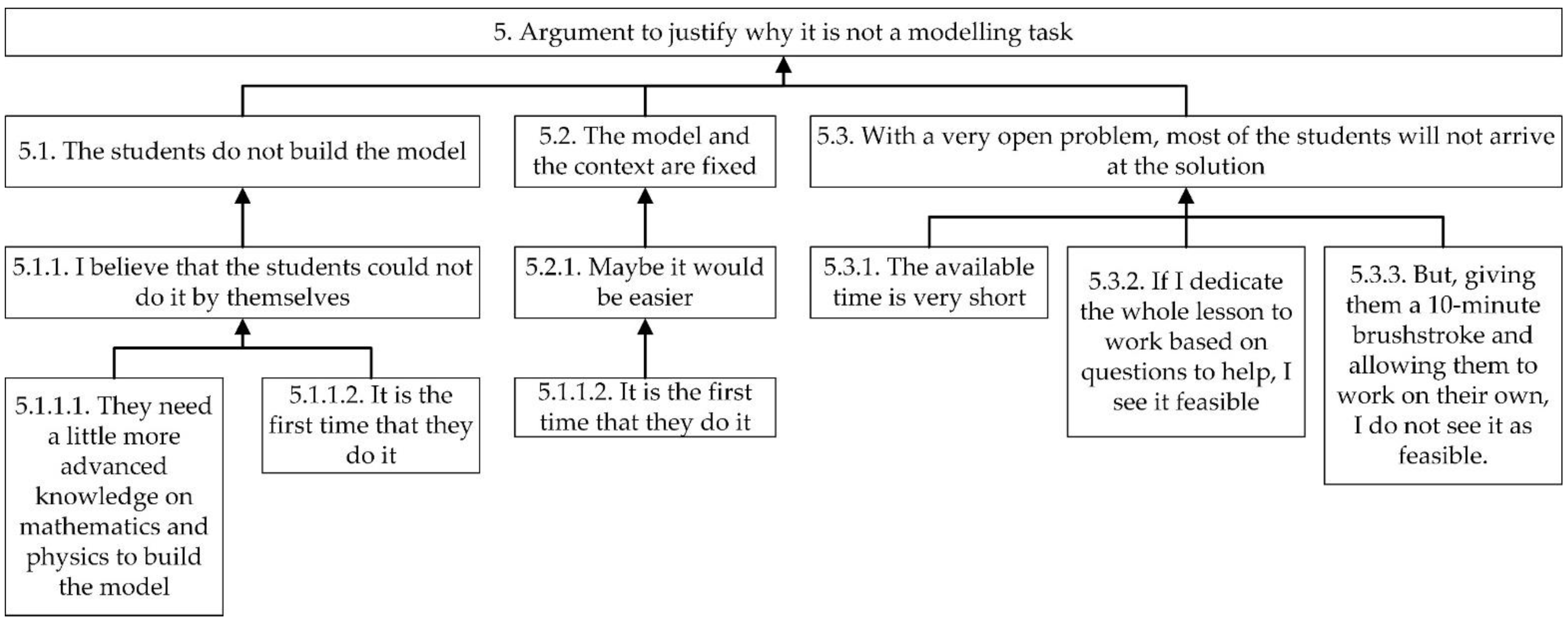
4.1.4. Concluding Stage
- Considering the cognitive level of the students, it is not possible to pose an open problem for modelling.
- It was decided to reduce the mathematical richness by giving the model to the students (this task and its redesign are analyzed in Section 4.2.3).
- For the redesign proposal, it is necessary to: (a) propose working on the task in a group, considering the advantages of this way of working; and (b) modify the wording of the modelling task to customize the situation to the students’ context.
- Considering the situation of the context in which the didactic unit was implemented, it can be assumed that the proposed modelling task did not necessarily meet all the characteristics of a modelling problem.
4.2. Analysis of the Study Subject’s MFP
4.2.1. DSC Components Related to Modelling
- Epistemic criterion: ‘Richness of processes’ and ‘Representativeness of the complexity of the mathematical object’ components.
- Cognitive criterion: ‘Prior knowledge’, ‘Learning’, and ‘High cognitive demand’ components.
- Interactional criterion: ‘Student interaction’ and ‘Autonomy’ components.
- Mediational criterion: We did not find keywords or comments on modelling in any of the components of this criterion.
- Affective criterion: ‘Interest and needs’ component.
- Ecological criterion: We found keywords and comments on modelling in the four components of this criterion.
4.2.2. Diagramming
1 {It is clear that the proposed activities must not only represent an exemplification of mathematical concepts, but must also contribute to the work of competences that put into play the students’ abilities, knowledge, attitudes, and skills through cognitive processes}. 2 {In this sense, the central axis of the didactic unit is the modelling process that allows many tools to work on different competences}. […]. Competence 1. Translate a problem into mathematical language or mathematical representation using appropriate variables, symbols, diagrams, and models. 3 {This competence has been extensively worked on in all the modelling problems, especially in sessions 2, 7, and 8, as well as in the synthesis work, which in the end could not be taken to the classroom}. 4 {Here, the expression of the problems in algebraic, graphical, or table form stands out, which has been integrated into all the modelling problems}, 5 {not only in order to see the different forms of expression of the problem}, but also 6 {the student’s abstraction capability to understand a situation in a ‘real’ context} such as 7 {buying fruit in session 2, calculating the speed of a runner in session 7, or the choice of the best rate of mobile operators}. Related to this competence, 8 {intense work has been done on the processes of problem solving and conversion between different representations of functions}, 9 {in this case, between natural and mathematical languages (translation)}. In all cases 10 {it has been insisted that the mathematical translation be formally correct}, 11 {always trying that the student correctly assigns and defines the independent and dependent variable(s), considering the units and their compatibility and coherence, as well as unit conversion where appropriate}. Competence 5. Construct, express, and contrast arguments to justify and validate the statements made in mathematics. At the same time, the previous competence, and especially in the modelling problem posed in session 8, 12 {the student is encouraged to make small conjectures} about the rate behavior of a service or, at least, 13 {to propose a thesis and mathematically check it}, 14 {forcing the student to build a model}, 15 {to express more or less real situations through the model}, and 16 {to contrast information or check whether the statements are correct or not}. 17 {In terms of processes, mathematical argumentation has been worked on}. 18 {Modelling problems, in general, always propose not only to model, but also to apply this model to a situation, often very close to reality} 19 {(for which I would also work intensively on competences 6 and 7 from the mathematical area, that is ‘Use mathematical reasoning in non-mathematical environments’ and ‘Identify the mathematics involved in close and academic situations and look for situations that can be related to concrete mathematical ideas’)}. 20 {The process associated with these competences would be contextualization}.([67], pp. 4–5)

11 {In the contextualized examples and, above all, in the modelling problems, the change in the conception of function has been used as a tool for analysis and problem solving}, 12 {starting from an abstract vision of function as a relation of variables}, 13 {adding meaning to these variables, in order to identify the independent and dependent variables of a problem in its context} to, 14 {finally, enable the algebraic representation of a function}. Beyond the conception of function as a relation of magnitudes or variables, 15 {a vision of function as a subset of the cartesian product of two sets has been introduced in class, that is, a vision as a set}. For example, 16 {in the modelling problem of buying oranges, when algebraically expressing the function, its domain and range as an abstract mathematical function was one}, but, 17 {if we conceive function as a relation of magnitudes, that domain and range are restricted}, since 18 {the purchase of a negative mass of oranges or obtaining negative costs of a purchase does not represent an easy interpretation}, (despite the fact that these could be interpreted as sales), so 19 {the characteristics of domain and range of a function can differ for the same algebraic representation, defining in itself different functions depending on the domain considered, that is, different functions that, despite having the same algebraic expression, they differ depending on the subset of independent variables considered (vision of a function as a subset of the cartesian product)}. 20 {To a lesser extent, the verbal expression of a function has been explicitly worked on, that is, it has not been asked as an objective to verbally express a function}, but 21 {the oral expression of a function has been worked on in the context of the model development}, so 22 {this representation has been worked on, albeit implicitly}.([67], pp. 6–7)
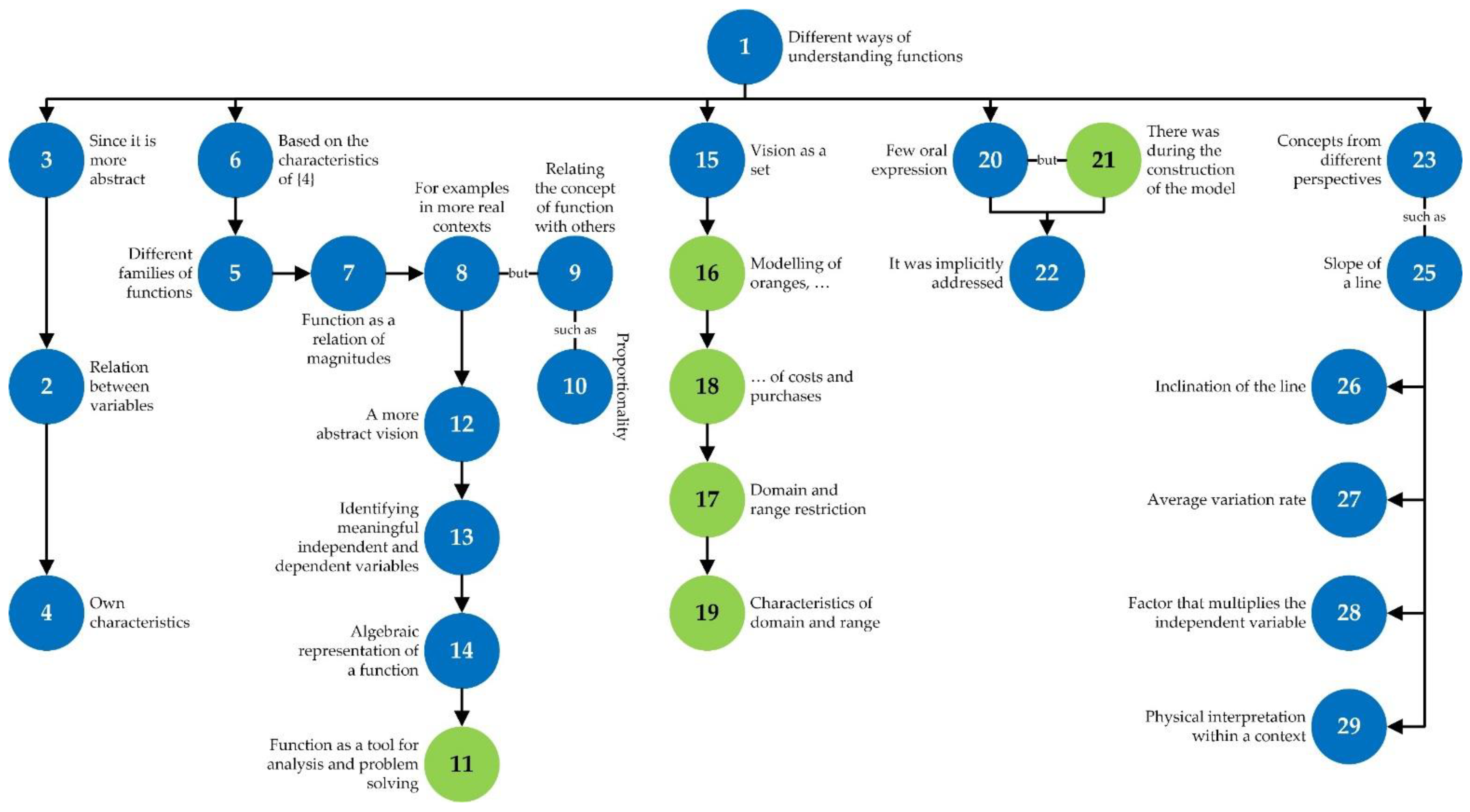
3 {The objective of this initial evaluation was focused on analyzing the student knowledge of units of measurement and unit conversion}, 4 {to see their mastery of the topic}, 5 {which is essential for modelling and contextualized exercises and problems}. In addition, 6 {it is where there may be more level of disparity between students}, since 7 {units of measurement and unit conversion are not only addressed in mathematics}. 8 {The assessed prior knowledge is the algebraic manipulation of linear equations}, 9 {to see if students will be able to work with functions algebraically expressed with sufficient ease so that, in modelling problems, the algebraic manipulation not be an impediment to exercise solving}. In general, 10 {it can be seen that, in terms of knowledge and unit conversion, six students have made two errors or more in the three-unit conversion questions} and that, therefore, 11 {may have problems when following the modelling problems}.([67], p. 7)

However, 5 {the cognitive demand is conditioned} by the 6 {structure of the didactic unit, with problems based on modelling processes}. 7 {In these problems is where the cognitive demand on the student is higher}. First of all, 8 {every modelling problem required a first phase of understanding the context (contextualization)} 9 {to define what the variables are {independent and dependent)} and 10 {in what units they want to be represented (conversion from natural to mathematical language)}. 11 {Here we already find a first degree of abstraction that, as verified in the final exam, many times modelling problems are solved}, but 12 {it is difficult for students to formally determine the variables and, therefore, they reach the maximum degree of abstraction of the problem, which will entail the representation of the problem in the form of a function, typically expressed in algebraic form, in order to be mathematically analyzed}. 13 {This conversion process is carried out in all the modelling problems proposed in this didactic unit that is analyzed}. Beyond the conversion, 14 {modelling problems allow the student to propose solving specific situations}, so that 15 {they must propose different situations or theses} and 16 {verify them from the model (mathematical argumentation)}, such as, for example, in the modelling problem of session 8, 17 {where the student is asked to determine which mobile rate is more convenient}. 18 {This problem can be solved by calculating the costs for each situation that the problem poses}, or 19 {by performing a change of representation, plotting the costs of the different companies (treatment) and, from the cut-off point of the functions, see from which mobile consumption one company or another pays better}. 20 {In this last resolution model, the cognitive demand is higher}, not only 21 {due to the higher degree of abstraction that the student needs}, but 22 {due to changes in representation} and 22 {the fact of correctly interpreting the cut-off points of the functions}, 23 {to make deductions of what happens in reality with the cost of the mobile}. Moreover, it is important to note that 24 {in the modelling process we have a first step of generalization and abstraction} 25 {when building and expressing the model}, but also, 26 {a concrete exercise} 27 {when the mathematical results must be interpreted} 28 {to draw conclusions in the context of the problem (contextualization)}. Many times, like, 29 {for example, in the problem proposed in session 2 about the purchase of oranges}, 30 {the purely mathematical analysis of the function represented by the model would have characteristics such as the domain and range} which, later, 31 {its concretion to the real context of the problem makes both the domain and the range make sense in more restricted intervals} (since the purchase of a negative mass of oranges or obtaining negative costs of a purchase does not present an easy interpretation), 32 {when passing from the interpretation of a function as a relation of variables to that of a relation of magnitudes}. 33 {It is therefore thanks to the modelling problems that this richness of nuances can be presented in the definition of function and to be able to exemplify what it is for taking them into account}. 34 {This process requires a high cognitive demand}.([67], pp. 9–10)
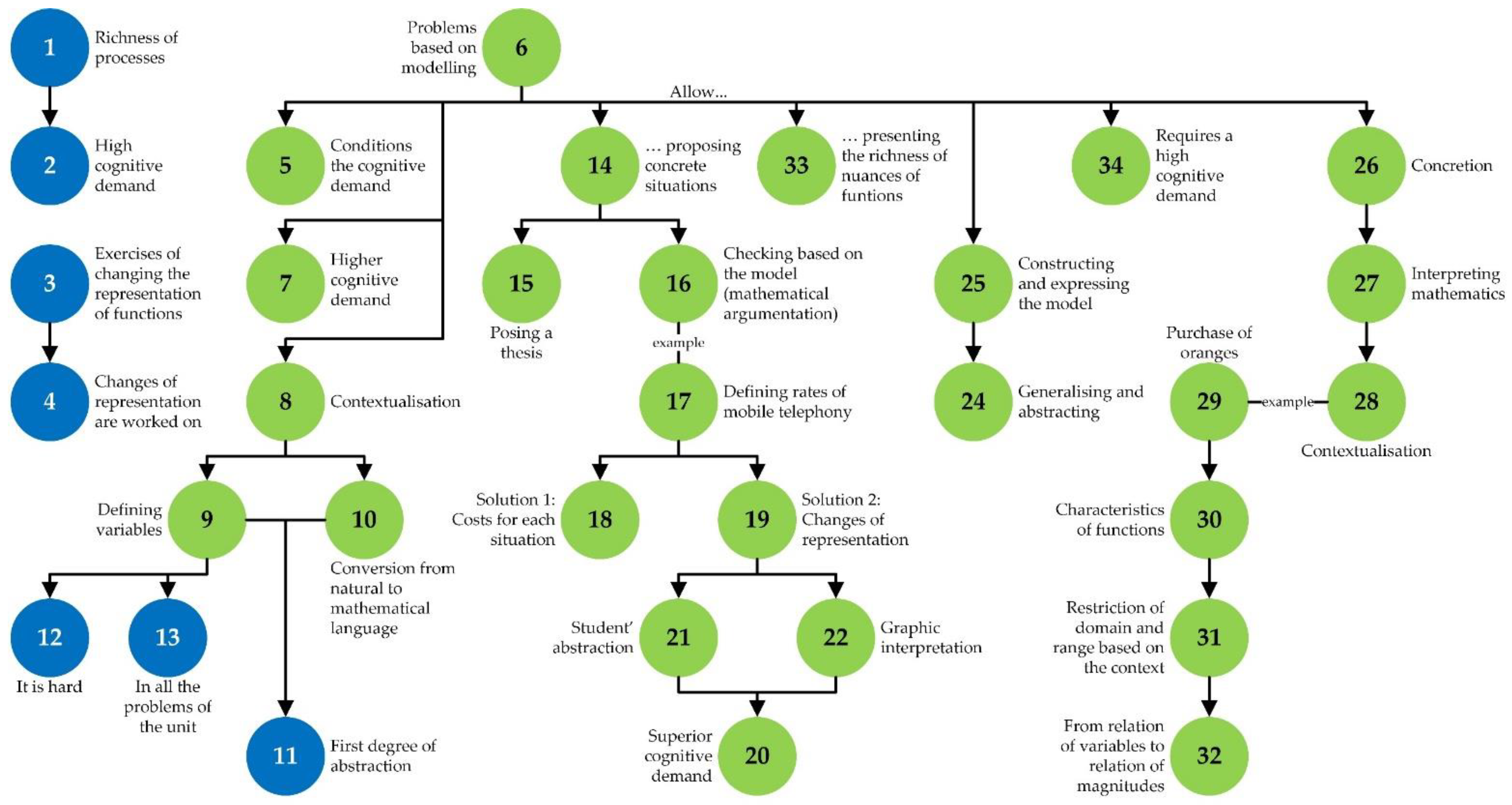
3 {Initially, I wanted that part of the synthesis work of the didactic unit (Annex 3) to be worked on in virtual groups among themselves}, but 4 {the lack of habit of the group in these work dynamics and the advice from the mentor teacher made me change my mind}. 5 {Unfortunately, the fact that some sessions were cancelled} 6 {because of students’ activities outside the classroom (outings and gymkhanas)}, 7 {meant that, finally, the synthesis work had to be suspended}, which is where 8 {it was expected to further enhance the student interaction}. In group meetings, 9 {the students commented on how they thought the problems were solved and tried to explain why they tried one way or another}. Finally, 10 {they reached consensus (or not) after consulting with the teacher}.([67], pp. 11–12)
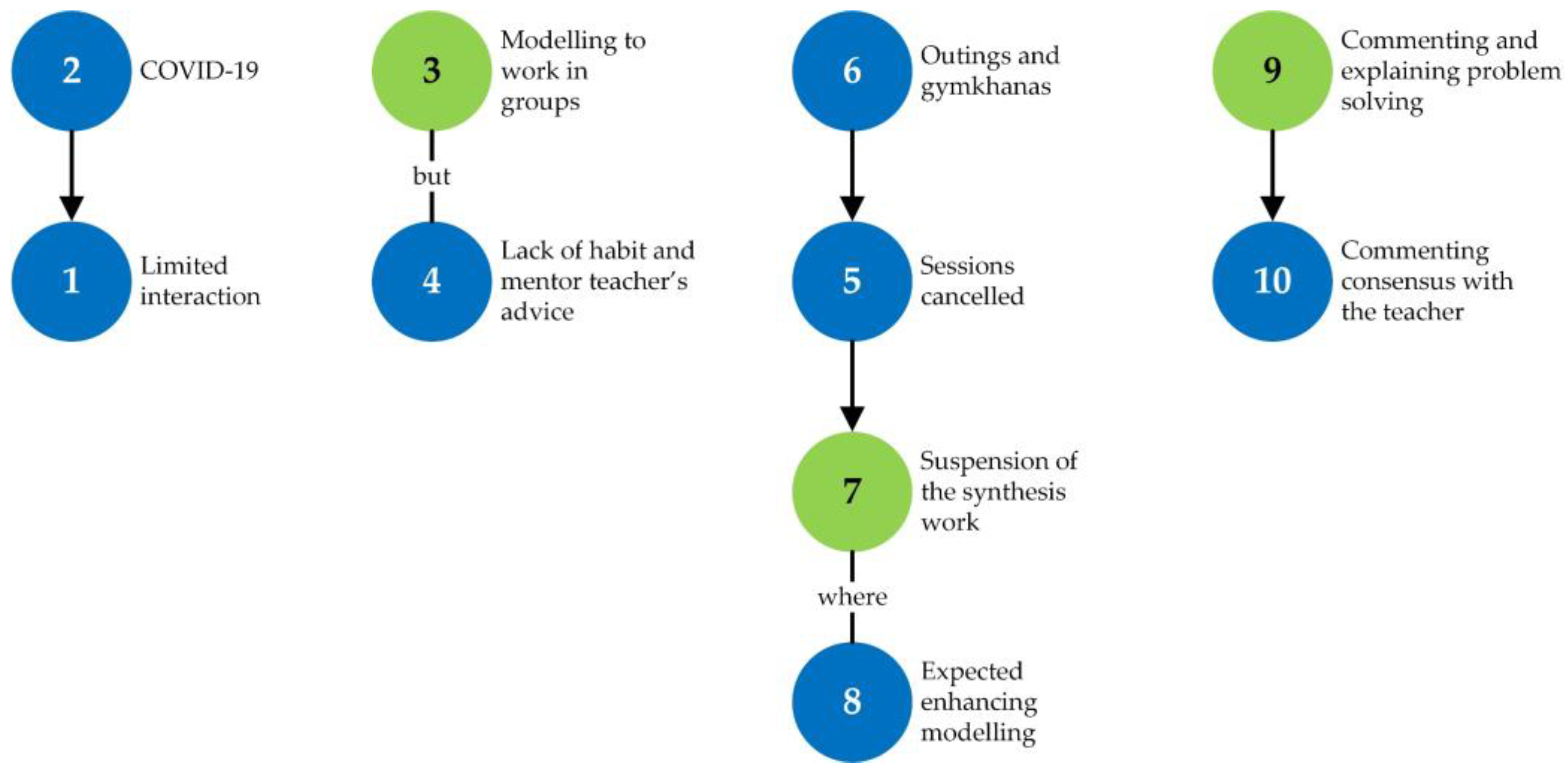
3 {Given this lack of autonomy during the classes, I wanted to take advantage of the synthesis work to increase this autonomy}, 4 {letting the students do part of this work on their own outside the classroom}. By not being able to introduce the synthesis work, it was not possible to enhance the autonomy of the group. 5 {Modelling problems, by requiring the student to make decisions in various processes}, 6 {tend to increase autonomy and, when reaching solutions, create a certain feeling of self-esteem for having solved a problem that, being contextualized, is perceived as something related to reality}.([67], p. 12)
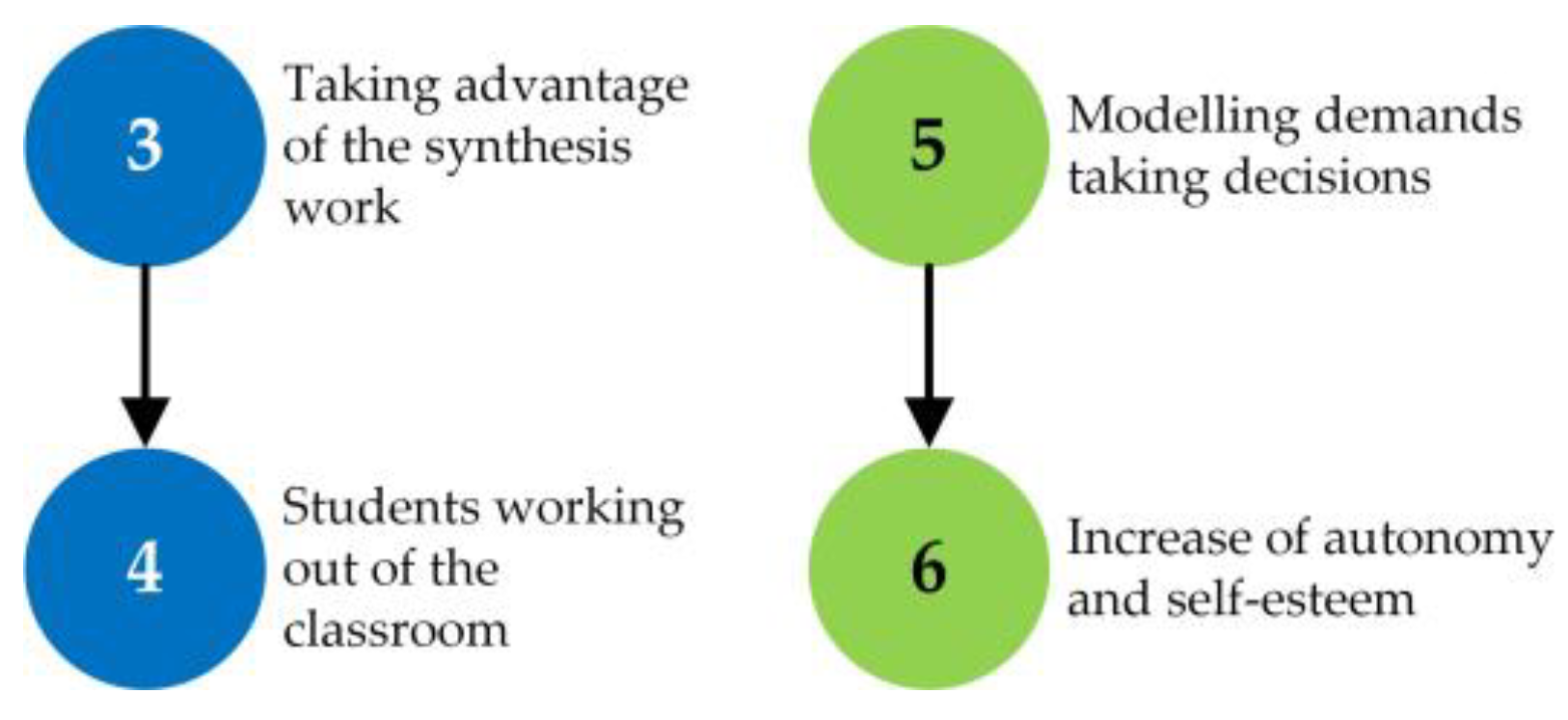
1 {The exercises in class, in general, were for practicing}, 2 {but the modelling problems, distributed throughout the didactic unit, were contextualized to appeal to everyday situations where the students felt identified}. 3 {No typical contexts have been introduced to attract the attention of the students such as football, movies, videogames, or something like that}. Although 4 {these topics connect with the interests of the vast majority of students}, 5 {they end up provoking non-mathematical debates that do not contribute to improving the work climate in the classroom}, on the other hand, 6 {everyday situations, where many times they identify themselves in adult situations, they also find them attractive and, above all, if they incorporate the economic factor}. This, 7 {the contexts proposed by the three modelling problems defined for the didactic unit are the purchase of products in bulk (oranges), the analysis of the speed of a runner in a race, and the choice of a rate of mobile telephony among different options}. Likewise, 8 {in the final exam, a contextualized modelling problem was included when looking for the most appropriate hiring rate for a gym service based on its use}. 9 {The objective of this contextualization of problems was also aimed at showing the students that mathematical knowledge is not only a tool for those who want to continue their studies in baccalaureate education}, but also 10 {is found and useful in close and everyday environments}.([67], pp. 14–15)
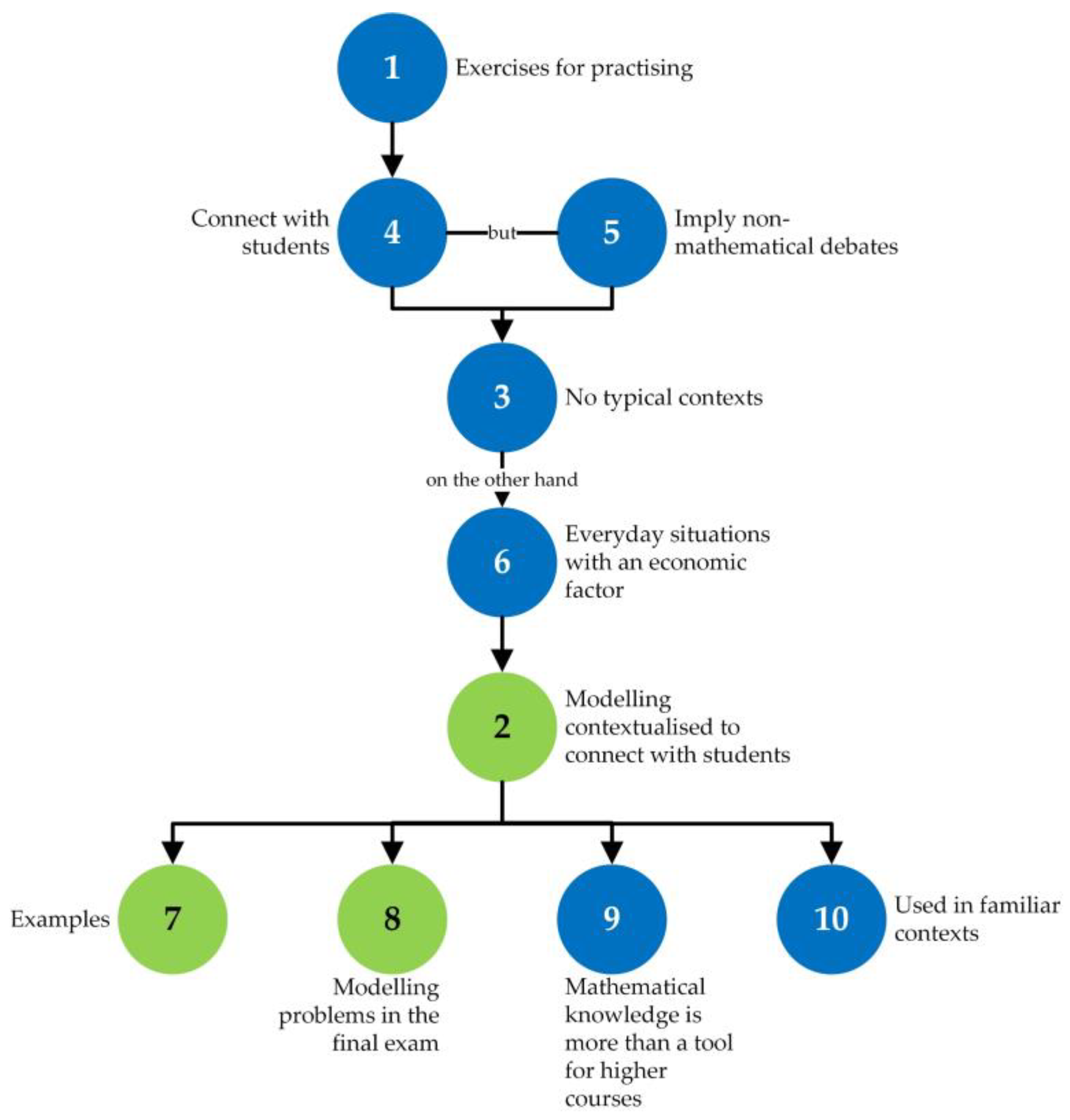
4 {Finally, the point use of functions for solving problems in different contexts is fully covered with the use of modelling problems, which have been solved in the didactic unit}.([67], p. 16)
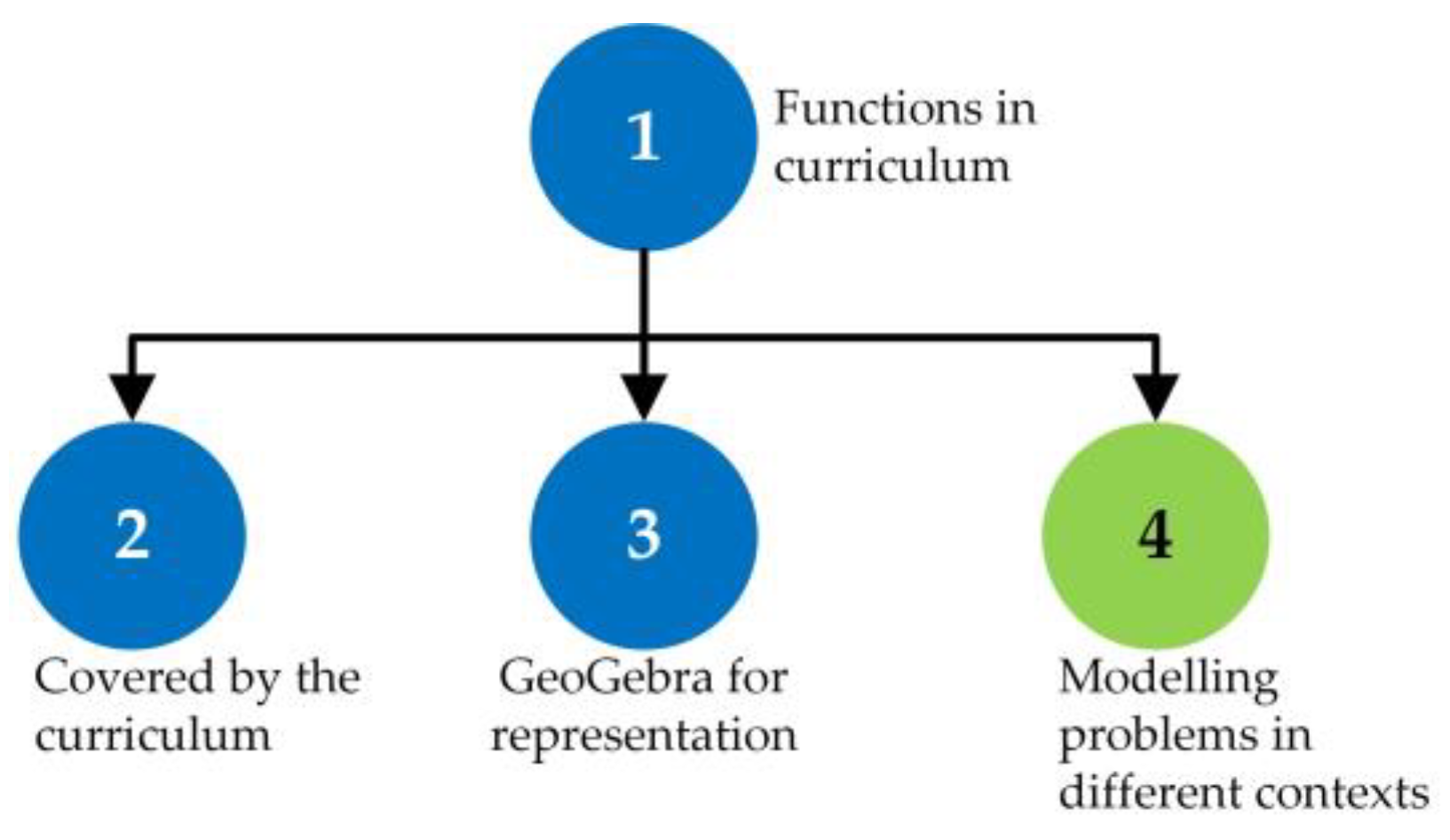
1 {The intradisciplinary connections (within mathematics) of the didactic unit are continuous}. […]. 3 {The interdisciplinary connections are also multiple}, 4 {given the nature of the didactic unit of functions}, 5 {there are obvious connections with the physics and technology subjects}, 6 {specially, due to the use of modelling in problems, which is natural in these disciplines}. […]. It has not been formally established in the development of the didactic unit, but it could be easily given the connection with social sciences or economics subjects.([67], p. 17)
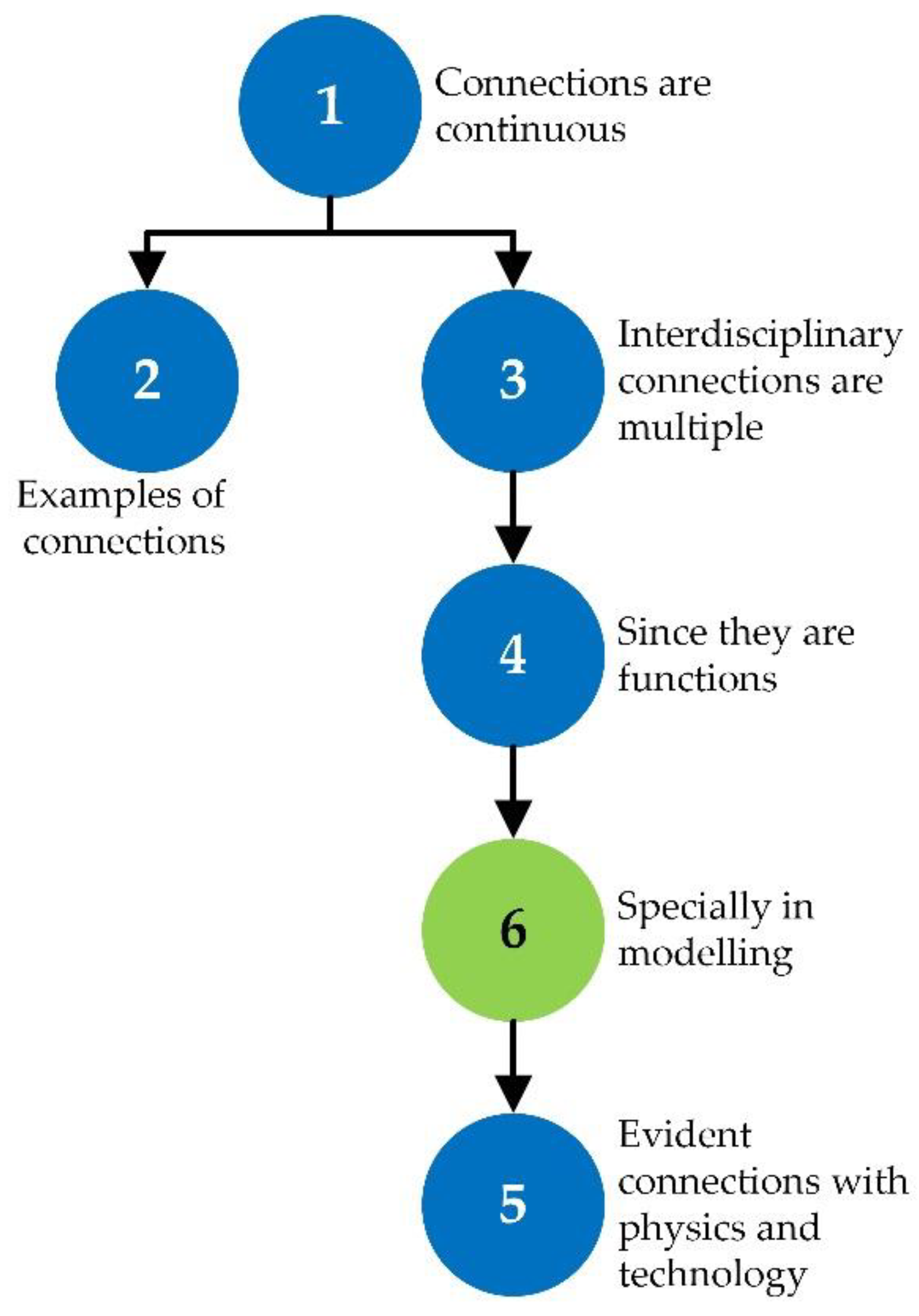
1 {The social and labor utility of functions has been exposed, mainly, from modelling problems, which have been contextualized in everyday situations}. 2 {The labor utility, perhaps, is further away from third grade of secondary education students} and, even so, it has been commented on. 3 {The social utility, which I believe may be closer to 3rd grade of secondary education students}, 4 {has been introduced from the contextualization of the contexts proposed by the three modelling problems defined for the didactic unit}, which are the purchase of products in bulk (oranges), the analysis of the speed of a runner in a race, and the choice of a mobile phone rate among different options. 5 {These are everyday situations, which avoid grandiloquent statements}, but which I believe 6 {project the image of the usefulness of mathematics on a day-to-day basis and, therefore, the need and convenience of learning them}. 7 {The problems based on modelling processes are usually realistic and authentic}, which 8 {shows their usefulness in everyday life and not only in special and professional situations}.([67], p. 17)
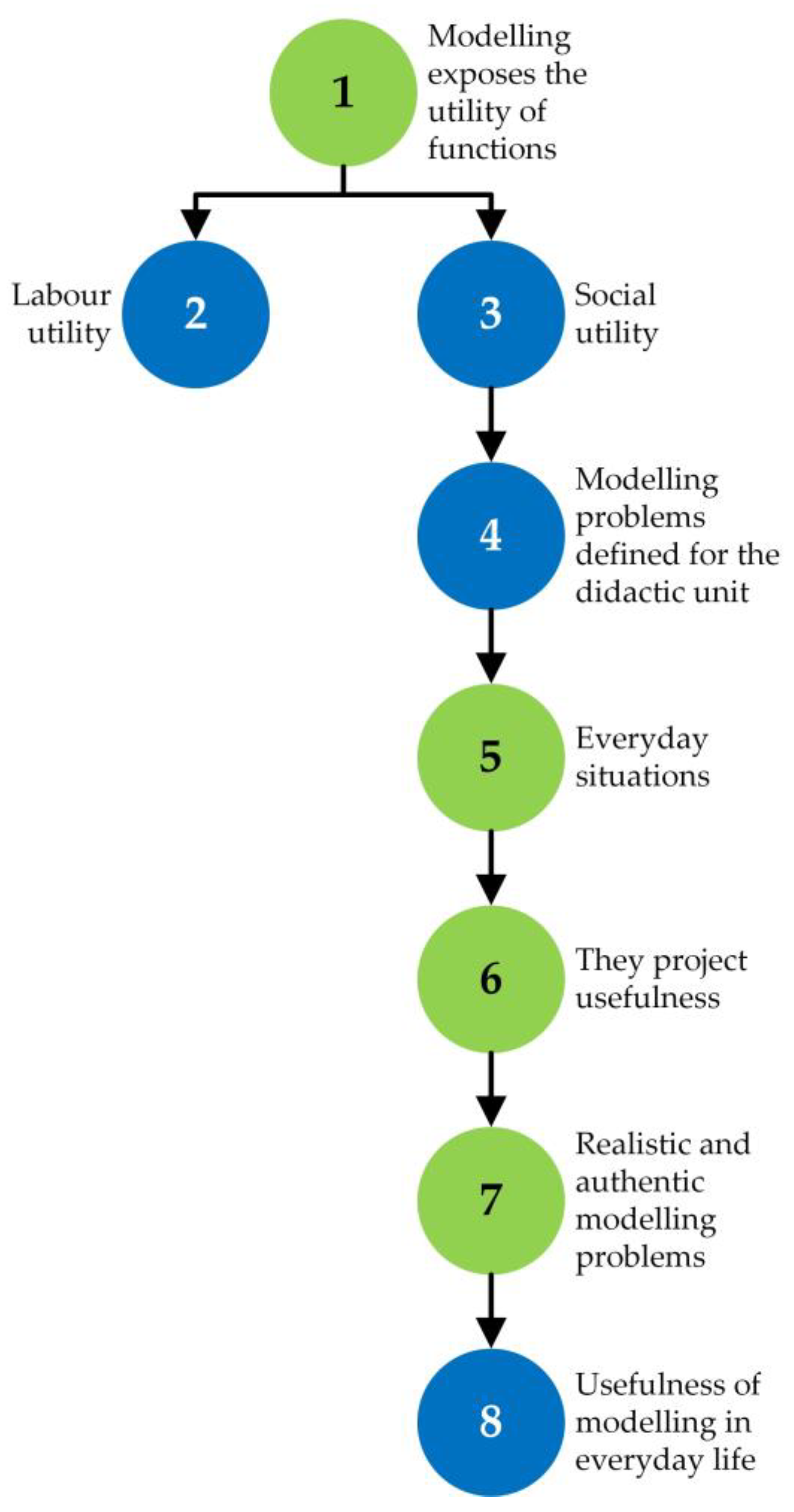
1 {The innovation in this didactic unit does not come from the content, which is the classic, but from two aspects}. 2 {Firstly, the use of modelling as a central axis of the didactic unit}, 3 {which allows to propose contextually rich problems to the students}, and 4 {which allow different mathematical competences to be worked on}, such as those discussed in Section 3.1.3 dedicated to the analysis of richness of processes. In this sense, 5 {it is difficult for me to imaging the fact of proposing this didactic unit of functions without using modelling}. Moreover, during the didactic unit, 6 {{software such as GeoGebra} 7 {was used to immediately visualize the graphical representations of functions} and 8 {encourage the change of representation} as a tool 9 {to solve problems or understand concepts in class}.([67], p. 17)
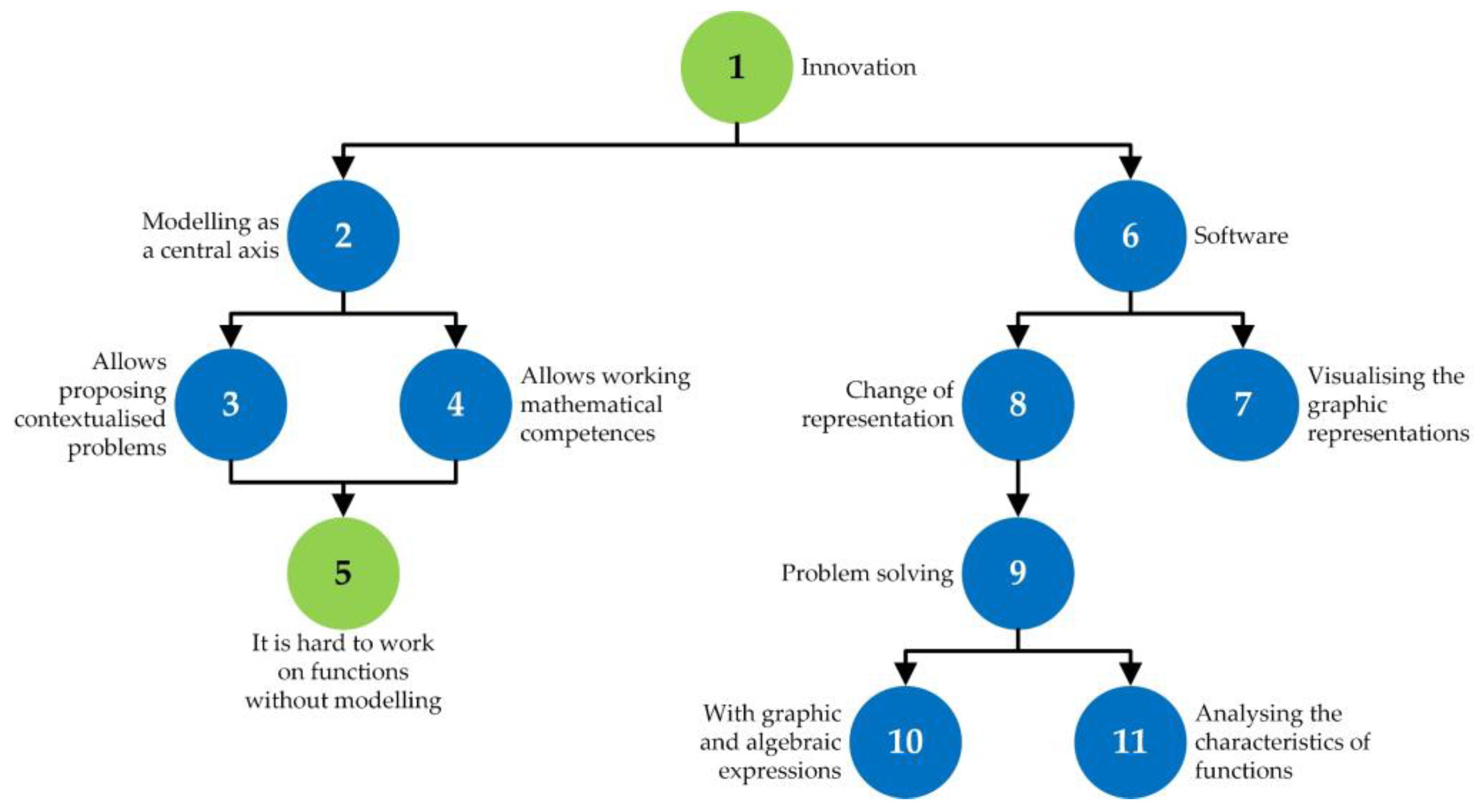
4.2.3. Modelling Task
- : Fuel consumption per real distance (expressed in litres per 100 km).
- : Fuel consumption per standard distance (reported by the manufacturer; expressed in liters per 100 km).
- : Mass of the vehicle (without additional load; expressed in kg).
- : Mass loaded by the vehicle (passengers, packages; expressed in kg).
- : Fuel consumption at idle (expressed in litres; a constant of 3 liters per hour is estimated).
- : Time that the vehicle is stopped (expressed in hours).
- : Total fuel consumption (expressed in litres).
- : Distances travelled (expressed in km).
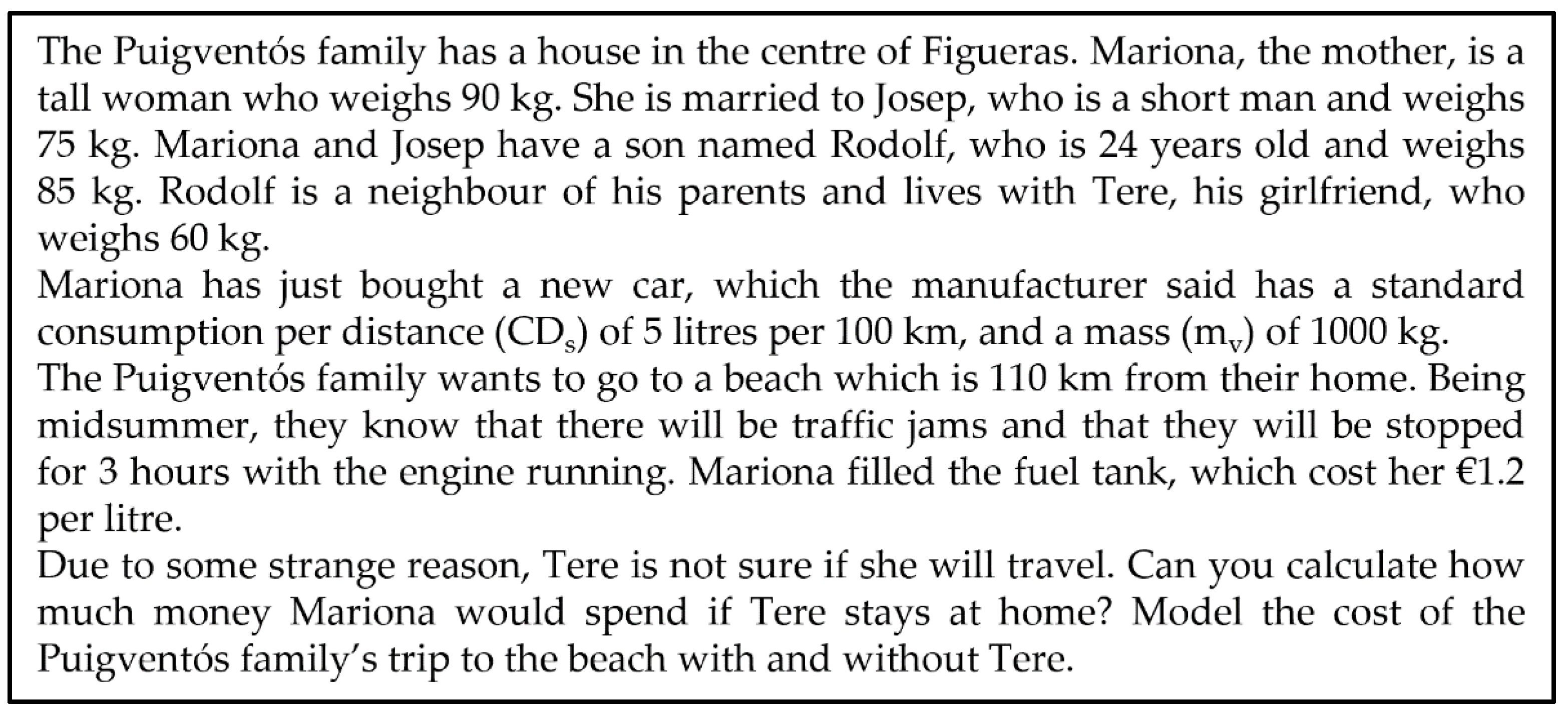
- The situation is neither open nor complex because, on one hand, the solving procedure is determined by the application of the formulas—or ‘mathematical models’—that were mentioned in Table 2 and, on the other hand, the wording of the task provides all the information necessary for its solving.
- Although the wording of the task is realistic, by adding elements from the real world (the Puigventós family, the car, the trip to the beach), the situation described contains numerical values that were defined to obtain certain results, so we cannot consider it like an authentic situation.
- Finally, and taking into account the two points raised above, this task cannot be considered as a modelling problem, which is why its solving cannot be carried out or explained in terms of a modelling cycle.

- The situation now is more open and complex since, although the procedure is still determined by the applications of the formulas in Table 2, now it is the students who must search for the necessary data to be able to solve the task.
- The wording of the task now includes a more realistic and authentic situation since, derived from the previous point, the opening of the problem now allows the information to be adapted to the context of each student, with variables, such as the price of a liter of fuel in their environment, the data of consumption and mass of the family vehicle, the distance from their home to a beach of free choice, etc.
- Finally, taking into account that this task was redesigned for a new hypothetical implementation of the didactic unit, it could be considered as a problem, as long as the students have not previously experimented with the originally designed task. In the same way, the solving of the redesigned task can be solvable through a modelling cycle.

5. Discussion and Conclusions
5.1. On the Group Reflection Sessions
5.2. On the Assessment of the Didactic Unit in the MFP
5.3. Conclusions
Author Contributions
Funding
Data Availability Statement
Acknowledgments
Conflicts of Interest
References
- Hill, H.C.; Ball, D.L.; Schilling, S.G. Unpacking pedagogical content knowledge: Conceptualizing and measuring teachers’ topic-specific knowledge of students. J. Res. Math. Educ. 2008, 39, 372–400. [Google Scholar] [CrossRef]
- Neubrand, M. Conceptualizations of professional knowledge for teachers of mathematics. ZDM 2018, 50, 601–612. [Google Scholar] [CrossRef]
- Petrou, M.; Goulding, M. Conceptualising teachers’ mathematical knowledge in teaching. In Mathematical Knowledge in Teaching; Rowland, T., Ruthven, K., Eds.; Springer: Dordrecht, The Netherlands, 2011; pp. 9–25. [Google Scholar] [CrossRef]
- Rowland, T. The Knowledge Quartet: The genesis and application of a framework for analysing mathematics teaching and deepening teachers’ mathematics knowledge. SISYPHUS—J. Educ. 2013, 1, 15–43. [Google Scholar] [CrossRef]
- Rowland, T.; Huckstep, P.; Thwaites, A. Elementary teachers’ mathematics subject knowledge: The knowledge quartet and the case of Naomi. J. Math. Teach. Educ. 2005, 8, 255–281. [Google Scholar] [CrossRef]
- Schoenfeld, A.H.; Kilpatrick, J. Towards a theory of proficiency in teaching mathematics. In The International Handbook of Mathematics Teacher Education Vol. 2: Tools and Processes in Mathematics Teacher Education; Tirosh, D., Woods, T., Eds.; Sense Publishers: Rotterdam, The Netherlands, 2008; pp. 321–354. [Google Scholar]
- Shulman, L.S. Knowledge and teaching: Foundations of the new reform. Harv. Educ. Rev. 1987, 57, 1–23. [Google Scholar] [CrossRef]
- Kunter, M.; Kleickmann, T.; Klusmann, U.; Richter, D. The development of teachers’ professional competence. In Cognitive Activation in the Mathematics Classroom and Professional Competence of Teachers: Results from the COACTIV Project; Kunter, M., Baumert, J., Blum, W., Klusmann, U., Krauss, S., Neubrand, M., Eds.; Springer: New York, NY, USA, 2013; pp. 63–77. [Google Scholar] [CrossRef]
- Leuders, T.; Dörfler, T.; Leuders, J.; Philipp, K. Diagnostic competence of mathematics teachers: Unpacking a complex construct. In Diagnostic Competence of Mathematics Teachers: Unpacking a Complex Construct in Teacher Education and Teacher Practice; Leuders, T., Philipp, K., Leuders, J., Eds.; Springer: New York, NY, USA, 2018; pp. 3–31. [Google Scholar] [CrossRef]
- Zaslavsky, O.; Sullivan, P. Setting the stage: A conceptual framework for examining and developing tasks for mathematics teacher education. In Constructing Knowledge for Teaching Secondary Mathematics: Tasks to Enhance Prospective and Practicing Teacher Learning; Zaslavsky, O., Sullivan, P., Eds.; Springer: New York, NY, USA, 2011; pp. 1–19. [Google Scholar] [CrossRef]
- An, S.; Wu, Z. Enhancing mathematics teachers’ knowledge of students’ thinking from assessing and analyzing misconceptions in homework. Int. J. Sci. Math. Educ. 2012, 10, 717–753. [Google Scholar] [CrossRef]
- Bell, C.A.; Wilson, S.; Higgins, T.; McCoach, D.B. Measuring the effects of professional development on teacher knowledge: The case of developing mathematical ideas. J. Res. Math. Educ. 2010, 41, 479–512. [Google Scholar] [CrossRef]
- Blömeke, S.; Delaney, S. Assessment of teacher knowledge across countries: A review of the state of research. ZDM 2012, 44, 223–247. [Google Scholar] [CrossRef]
- Davis, B. Is 1 a prime number? Developing teacher knowledge through concept study. Math. Teach. Middle Sch. 2008, 14, 86–91. [Google Scholar] [CrossRef]
- Fernández, C.; Yoshida, M. Lesson Study: A Japanese Approach to Improving Mathematics Teaching and Learning; Routledge: New York, NY, USA, 2004. [Google Scholar] [CrossRef]
- Fortuny, J.M.; Rodríguez, R. Aprender a mirar con sentido: Facilitar la interpretación de las interacciones en el aula. AIEM Av. Investig. En Educ. Matemática 2012, 1, 23–37. [Google Scholar] [CrossRef]
- Gellert, U.; Becerra, R.; Chapman, O. Research methods in mathematics teacher education. In Third International Handbook of Mathematics Education; Bishop, A., Clements, M.A.K., Keitel-Kreidt, C., Kilpatrick, J., Leung, F.K.-S., Eds.; Springer: New York, NY, USA, 2013; pp. 327–360. [Google Scholar] [CrossRef]
- Korthagen, F.A.J. La práctica, la teoría y la persona en la formación del profesorado. RIFOP Rev. Interuniv. Form. Del Profr. 2010, 68, 83–101. [Google Scholar]
- Llinares, S. Construcción de conocimiento y desarrollo de una mirada profesional para la práctica de enseñar matemáticas en entornos en línea. AIEM Av. Investig. En Educ. Matemática 2012, 2, 53–70. [Google Scholar] [CrossRef]
- Kaiser, G. Mathematical modelling and applications in education. In Encyclopedia of Mathematics Education, 2nd ed.; Lerman, S., Ed.; Springer: Cham, Switzerland, 2020; pp. 553–561. [Google Scholar] [CrossRef]
- Blum, W. Can modelling be taught and learnt? Some answers from empirical research. In Trends in Teaching and Learning of Mathematical Modelling: ICTMA 14; Kaiser, G., Blum, W., Borromeo, R., Stillman, G., Eds.; Springer: Dordrecht, The Netherlands, 2011; pp. 15–30. [Google Scholar] [CrossRef]
- Blum, W.; Borromeo, R. Mathematical modelling: Can it be taught and learnt? J. Math. Model. Appl. 2009, 1, 45–58. [Google Scholar]
- Breda, A.; Pochulu, M.; Sánchez, A.; Font, V. Simulation of teacher interventions in a training course of mathematics teachers educators. Mathematics 2021, 9, 3228. [Google Scholar] [CrossRef]
- Stillman, G.; Brown, J.P. Pre-service secondary mathematics teachers’ affinity with using modelling tasks in teaching years 8–10. In Trends in Teaching and Learning of Mathematical Modelling: ICTMA 14; Kaiser, G., Blum, W., Borromeo, R., Stillman, G., Eds.; Springer: Dordrecht, The Netherlands, 2011; pp. 289–298. [Google Scholar] [CrossRef]
- Doerr, H.M. What knowledge do teachers need for teaching mathematics through applications and modelling? In Modelling and Applications in Mathematics Education: The 14th ICMI Study; Blum, W., Galbraith, P.L., Henn, H.-W., Niss, M., Eds.; Springer: Boston, MA, USA, 2007; pp. 69–78. [Google Scholar] [CrossRef]
- Kaiser, G.; Maaß, K. Modelling in lower secondary mathematics classroom—Problems and opportunities. In Modelling and Applications in Mathematics Education: The 14th ICMI Study; Blum, W., Galbraith, P.L., Henn, H.-W., Niss, M., Eds.; Springer: Boston, MA, USA, 2007; pp. 99–108. [Google Scholar] [CrossRef]
- Kaiser, G.; Schwarz, B.; Tiedemann, S. Future teachers’ professional knowledge on modeling. In Modeling Students’ Mathematical Modeling Competencies: ICTMA 13; Lesh, R., Galbraith, P.L., Haines, C., Hurford, A., Eds.; Springer: Dordrecht, The Netherlands, 2013; pp. 433–444. [Google Scholar] [CrossRef]
- Wendt, L.; Vorhölter, K.; Kaiser, G. Teachers’ perspectives on students’ metacognitive strategies during mathematical modelling processes—A case study. In Mathematical Modelling Education and Sense-Making; Stillman, G., Kaiser, G., Lampen, C.E., Eds.; Springer: Cham, Switzerland, 2020; pp. 335–346. [Google Scholar] [CrossRef]
- Villa-Ochoa, J.A. Modelación matemática a partir de problemas de enunciados verbales: Un estudio de caso con profesores de matemáticas. Magis 2015, 8, 133–148. [Google Scholar] [CrossRef]
- Ledezma, C.; Sala, G.; Breda, A.; Sánchez, A. Analysis of a preservice teacher’s reflection on the role of mathematical modelling in his master’s thesis. In Proceedings of the 44th Conference of the International Group for the Psychology of Mathematics Education, 19–22 July 2021; Inprasitha, M., Changsri, N., Boonsena, N., Eds.; PME: Khon Kaen, Thailand, 2021; Volume 3, pp. 195–204. [Google Scholar]
- Ledezma, C.; Breda, A.; Sánchez, A.; Sala, G. Didactic suitability criteria related to reflection on the implementation of mathematical modelling in a virtual context. In Proceedings of the Twelfth Congress of the European Society for Research in Mathematics Education, Bozen-Bolzano, Italy, 2–6 February 2022; University of Bozen-Bolzano, ERME: Bolzano, Italy, forthcoming.
- Godino, J.D.; Batanero, C.; Font, V. The onto-semiotic approach to research in mathematics education. ZDM 2007, 39, 127–135. [Google Scholar] [CrossRef]
- van Eemeren, F.H.; Grootendorst, R. A Systematic Theory of Argumentation: The Pragma-Dialectical Approach; Cambridge University Press: New York, NY, USA, 2004. [Google Scholar]
- Guevara, G. Estructuras de argumentos. In Compendio de Lógica, Argumentación y Retórica; Vega, L., Olmos, P., Eds.; Trotta: Madrid, Spain, 2011; pp. 239–243. [Google Scholar]
- Toulmin, S.E. The Uses of Argument, updated ed.; Cambridge University Press: New York, NY, USA, 2003. [Google Scholar]
- Solar, H.; Ortiz, A.; Arriagada, V.; Deulofeu, J. Argumentative orchestration in the mathematical modelling cycle in the classroom. EURASIA J. Math. Sci. Tech. Ed. 2022, 18, em2141. [Google Scholar] [CrossRef]
- Tekin, A. Arguments constructed within the mathematical modelling cycle. Int. J. Math. Educ. Sci. Technol. 2019, 50, 292–314. [Google Scholar] [CrossRef]
- Borromeo, R. Theoretical and empirical differentiations of phases in the modelling process. ZDM 2006, 38, 86–95. [Google Scholar] [CrossRef]
- Abassian, A.; Safi, F.; Bush, S.; Bostic, J. Five different perspectives on mathematical modeling in mathematics education. Investig. Math. Learn. 2020, 12, 53–65. [Google Scholar] [CrossRef]
- Borromeo, R. Mathematical modelling in European education. J. Math. Educ. Teach. Coll. 2013, 4, 18–24. [Google Scholar]
- Geiger, V.; Mulligan, J.; Date-Huxtable, L.; Ahlip, R.; Jones, D.H.; May, E.J.; Rylands, L.; Wright, I. An interdisciplinary approach to designing online learning: Fostering pre-service mathematics teachers’ capabilities in mathematical modelling. ZDM 2018, 50, 217–232. [Google Scholar] [CrossRef]
- Blum, W.; Leiß, D. How do students and teachers deal with modelling problems? In Mathematical Modelling (ICTMA 12): Education, Engineering and Economics; Haines, C., Galbraith, P., Blum, W., Khan, S., Eds.; Horwood: Chichester, UK, 2007; pp. 222–231. [Google Scholar] [CrossRef]
- Reusser, K. Denkstrukturen und Wissenserwerb in der Ontogenese. In Sonderdruck aus Enzyklopädie der Psychologie, Themen-Bereich C: Theorie und Forschung, Serie II: Kognition, Band 6: Kognition; Klix, F., Spada, H., Eds.; Hogrefe: Göttingen, Germany, 1998; pp. 115–166. [Google Scholar]
- Verschaffel, L.; Greer, B.; de Corte, E. Making Sense of Word Problems; Swets & Zeitlinger: Lisse, The Netherlands, 2000. [Google Scholar]
- Maaß, K. What are modelling competencies? ZDM 2006, 38, 113–142. [Google Scholar] [CrossRef]
- Doerr, H.M.; English, L.D. A modeling perspective on students’ mathematical reasoning about data. J. Res. Math. Educ. 2003, 34, 110–136. [Google Scholar] [CrossRef]
- Shahbari, J.A.; Tabach, M. Adopting the modelling cycle for representing prospective and practising teachers’ interpretations of students’ modelling activities. In Lines of Inquiry in Mathematical Modelling Research in Education; Stillman, G.A., Brown, J.P., Eds.; Springer: Cham, Switzerland, 2019; pp. 179–196. [Google Scholar] [CrossRef]
- Blomhøj, M.; Kjeldsen, T.H. Teaching mathematical modelling through project work–Experiences from an in-service course for upper secondary teachers. ZDM 2006, 38, 163–177. [Google Scholar] [CrossRef]
- Blomhøj, M.; Kjeldsen, T.H. Interdisciplinary problem oriented project work—A learning environment for mathematical modelling. In Evaluierte Lernumgebungen zum Modellieren; Schukajlow, S., Blum, W., Eds.; Springer: Wiesbaden, Germany, 2018; pp. 11–29. [Google Scholar] [CrossRef]
- Borromeo, R. Learning How to Teach Mathematical Modeling in School and Teacher Education; Springer: Cham, Switzerland, 2018. [Google Scholar] [CrossRef]
- Palm, T. Features and impact of the authenticity of applied mathematical school tasks. In Modelling and Applications in Mathematics Education: The 14th ICMI Study; Blum, W., Galbraith, P.L., Henn, H.-W., Niss, M., Eds.; Springer: Boston, MA, USA, 2007; pp. 201–208. [Google Scholar] [CrossRef]
- Schoenfeld, A.H. Reflections on doing and teaching mathematics. In Mathematical Thinking and Problem Solving; Schoenfeld, A.H., Ed.; Erlbaum: Hillsdale, MI, USA, 1994; pp. 53–70. [Google Scholar]
- Breda, A.; Pino-Fan, L.; Font, V. Meta didactic-mathematical knowledge of teachers: Criteria for the reflection and assessment on teaching practice. EURASIA J. Math. Sci. Technol. Educ. 2017, 13, 1893–1918. [Google Scholar] [CrossRef]
- Godino, J.D.; Giacomone, B.; Batanero, C.; Font, V. Enfoque ontosemiótico de los conocimientos y competencias del profesor de matemáticas. BOLEMA Bol. Educ. Matemática 2017, 31, 90–113. [Google Scholar] [CrossRef]
- Pino-Fan, L.R.; Assis, A.; Castro, W.F. Towards a methodology for the characterization of teachers’ didactic-mathematical knowledge. EURASIA J. Math. Sci. Technol. Ed. 2015, 11, 1429–1456. [Google Scholar] [CrossRef]
- Pino-Fan, L.R.; Font, V.; Breda, A. Mathematics teachers’ knowledge and competences model based on the onto-semiotic approach. In Proceedings of the 41st Conference of the International Group for the Psychology of Mathematics Education, Singapore, 17–22 July 2017; Kaur, B., Ho, W.K., Toh, T.L., Choy, B.H., Eds.; PME: Singapore, 2017; Volume 4, pp. 33–40. [Google Scholar]
- Font, V.; Planas, N.; Godino, J.D. Modelo para el análisis didáctico en educación matemática. J. Study Educ. Dev.–Infanc. Y Aprendiz. 2010, 33, 89–105. [Google Scholar] [CrossRef]
- Breda, A.; Font, V.; Pino-Fan, L. Criterios valorativos y normativos en la Didáctica de las Matemáticas: El caso del constructo idoneidad didáctica. BOLEMA Bol. Educ. Matemática 2018, 32, 255–278. [Google Scholar] [CrossRef]
- Godino, J.D. Indicadores de la idoneidad didáctica de procesos de enseñanza y aprendizaje de las matemáticas. Cuad. Investig. Y Form. En Educ. Matemática 2013, 8, 111–132. [Google Scholar]
- Ledezma, C.; Font, V.; Sala, G. Analysing the mathematical activity in a modelling process from the cognitive and on-to-semiotic perspectives. Math. Educ. Res. J. 2022, 1–27. [Google Scholar] [CrossRef]
- Sala, G.; Font, V.; Giménez, J.; Barquero, B. Inquiry and modelling in a real archaeological context. In Mathematical Modelling and Applications: Crossing and Researching Boundaries in Mathematics Education; Stillman, G., Blum, W., Kaiser, G., Eds.; Springer: Cham, Switzerland, 2017; pp. 325–335. [Google Scholar] [CrossRef]
- Schön, D.A. The Reflective Practitioner: How Professionals Think in Action; Basic Books: New York, NY, USA, 1983. [Google Scholar]
- Pino-Fan, L.; Godino, J.D.; Font, V. Assessing key epistemic features of didactic-mathematical knowledge of prospective teachers: The case of the derivative. J. Math. Teach. Educ. 2018, 21, 63–94. [Google Scholar] [CrossRef]
- Peirce, C.S. The fixation of belief. Pop. Sci. Montly 1877, 12, 1–15. [Google Scholar]
- Cohen, L.; Manion, L.; Morrison, K. Research Methods in Education, 8th ed.; Routledge: New York, NY, USA, 2018. [Google Scholar]
- Stake, R.E. Qualitative case studies. In The SAGE Handbook of Qualitative Research, 3rd ed.; Denzin, N.K., Lincoln, Y.S., Eds.; Sage: Thousand Oaks, CA, USA, 2005; pp. 443–466. [Google Scholar]
- Deltell, A. Millora D’una Unitat Didàctica de Funcions a 3º de ESO, Emprant el Procés de Modelització Com a eix Vertebrador. Master’s Thesis, Autonomous University of Barcelona, Barcelona, Spain, 17 June 2021. [Google Scholar]
- Breda, A. Características del análisis didáctico realizado por profesores para justificar la mejora en la enseñanza de las ma-temáticas. BOLEMA Bol. De Educ. Matemática 2020, 34, 69–88. [Google Scholar] [CrossRef]
- Hidalgo-Moncada, D.; Vanegas, Y.; Díez-Palomar, J. Prácticas de autorregulación del aprendizaje de las matemáticas pro-movidas por futuros profesores. In Investigación en Educación Matemática XXIV; Diago, P.D., Yáñez, D.F., González-Astudillo, M.T., Carrillo, D., Eds.; SEIEM: Valencia, Spain, 2021; pp. 339–346. [Google Scholar]
- Sánchez, A.; Font, V.; Breda, A. Significance of creativity and its development in mathematics classes for preservice teachers who are not trained to develop students’ creativity. Math. Educ. Res. J. 2021, 1–23. [Google Scholar] [CrossRef]
- Departament d’Educació. Currículum Educació Secundària Obligatòria; Generalitat de Catalunya: Barcelona, Spain, 2019. [Google Scholar]
- Maaß, K. Classification scheme for modelling tasks. J. Für Math.-Didakt. 2010, 31, 285–311. [Google Scholar] [CrossRef]
- Blum, W. ICMI Study 14: Applications and modelling in mathematics education—Discussion document. Educ. Stud. Math. 2002, 51, 149–171. [Google Scholar] [CrossRef]
- Duval, R. Understanding the Mathematical Way of Thinking—The Registers of Semiotic Representations; Springer: Cham, Switzerland, 2017. [Google Scholar] [CrossRef]
- Michelsen, C. Functions: A modelling tool in mathematics and science. ZDM 2006, 38, 269–280. [Google Scholar] [CrossRef]
- Blomhøj, M.; Jensen, T.H. What’s all the fuss about competencies? Experiences with using a competence perspective on mathematics education to develop the teaching of mathematical modelling. In Modelling and Applications in Mathematics Education: The 14th ICMI Study; Blum, W., Galbraith, P.L., Henn, H.-W., Niss, M., Eds.; Springer: New York, NY, USA, 2007; pp. 45–56. [Google Scholar] [CrossRef]
- Ng, K.E.D.; Widjaja, W.; Chan, C.M.E.; Seto, C. Developing teacher competencies through videos for facilitation of mathematical modelling in Singapore primary schools. In Cases of Mathematics Professional Development in East Asian Countries: Using Video to Support Grounded Analysis; Ng, S.F., Ed.; Springer: Singapore, 2015; pp. 15–38. [Google Scholar] [CrossRef]
- Julie, C.; Mudaly, V. Mathematical modelling of social issues in school mathematics in South Africa. In Modelling and Appli-cations in Mathematics Education: The 14th ICMI Study; Blum, W., Galbraith, P.L., Henn, H.-W., Niss, M., Eds.; Springer: New York, NY, USA, 2007; pp. 503–510. [Google Scholar] [CrossRef]
- Niss, M. Issues and problems of research on the teaching and learning of applications and modelling. In Modelling and Mathematics Education: ICTMA 9—Applications in Science and Technology; Matos, J.F., Blum, W., Houston, K., Carreira, S.P., Eds.; Horwood: Chichester, UK, 2001; pp. 72–88. [Google Scholar] [CrossRef]
- Pollak, H.O. The interaction between mathematics and other school subjects. In New Trends in Mathematics Teaching IV; Christiansen, B., Fletcher, T.J., Revuz, A., Santaló, L.A., Steiner, H.-G., Eds.; UNESCO: Poitiers, France, 1979; pp. 232–248. [Google Scholar]
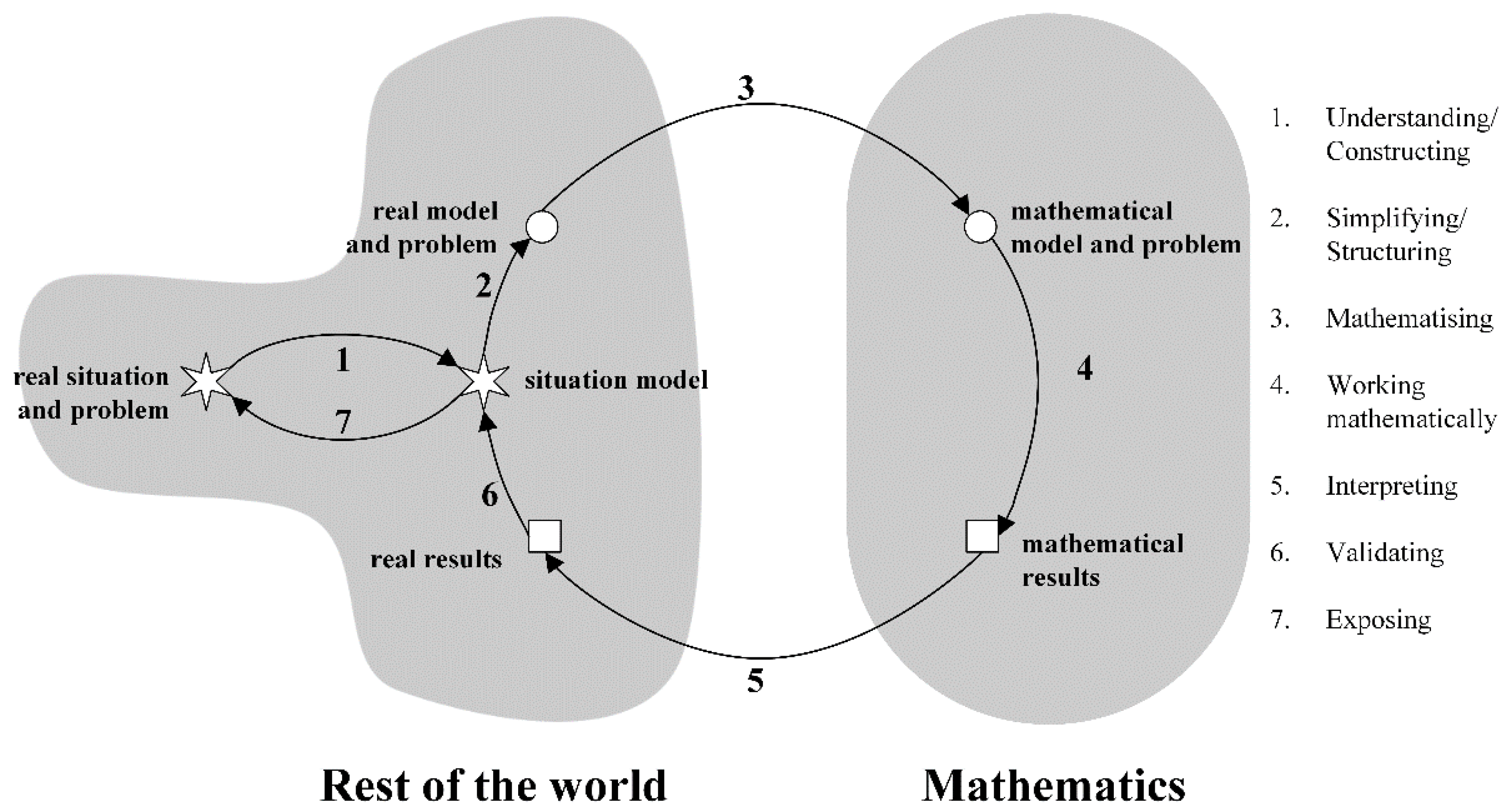
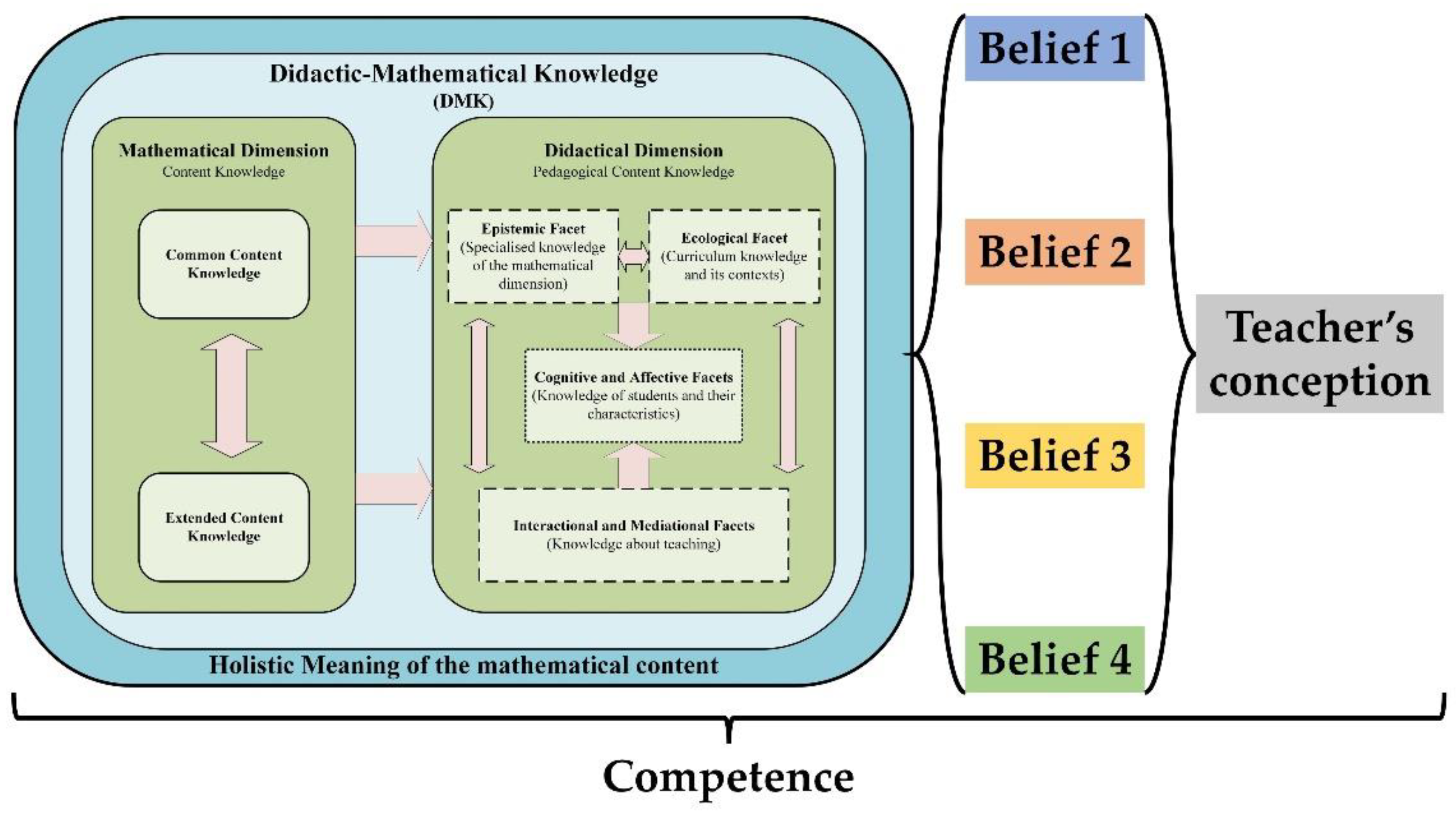
| Criteria | Components |
|---|---|
| Epistemic |
|
| Cognitive |
|
| Interactional |
|
| Mediational |
|
| Affective |
|
| Ecological |
|
| Description | Formulas |
|---|---|
| Real distance consumption | |
| Consumption at idle | |
| Total consumption |
Publisher’s Note: MDPI stays neutral with regard to jurisdictional claims in published maps and institutional affiliations. |
© 2022 by the authors. Licensee MDPI, Basel, Switzerland. This article is an open access article distributed under the terms and conditions of the Creative Commons Attribution (CC BY) license (https://creativecommons.org/licenses/by/4.0/).
Share and Cite
Ledezma, C.; Sol, T.; Sala-Sebastià, G.; Font, V. Knowledge and Beliefs on Mathematical Modelling Inferred in the Argumentation of a Prospective Teacher When Reflecting on the Incorporation of This Process in His Lessons. Mathematics 2022, 10, 3339. https://doi.org/10.3390/math10183339
Ledezma C, Sol T, Sala-Sebastià G, Font V. Knowledge and Beliefs on Mathematical Modelling Inferred in the Argumentation of a Prospective Teacher When Reflecting on the Incorporation of This Process in His Lessons. Mathematics. 2022; 10(18):3339. https://doi.org/10.3390/math10183339
Chicago/Turabian StyleLedezma, Carlos, Telesforo Sol, Gemma Sala-Sebastià, and Vicenç Font. 2022. "Knowledge and Beliefs on Mathematical Modelling Inferred in the Argumentation of a Prospective Teacher When Reflecting on the Incorporation of This Process in His Lessons" Mathematics 10, no. 18: 3339. https://doi.org/10.3390/math10183339
APA StyleLedezma, C., Sol, T., Sala-Sebastià, G., & Font, V. (2022). Knowledge and Beliefs on Mathematical Modelling Inferred in the Argumentation of a Prospective Teacher When Reflecting on the Incorporation of This Process in His Lessons. Mathematics, 10(18), 3339. https://doi.org/10.3390/math10183339








